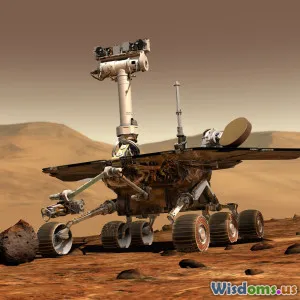
Are Mars Rovers the Next Big Leap for Life Detection
10 min read Exploring Mars rovers' groundbreaking potential in detecting life beyond Earth and advancing astrobiology. (0 Reviews)
Are Mars Rovers the Next Big Leap for Life Detection?
The quest to find life beyond Earth has been a fundamental driver of space exploration, sparking the imagination of scientists and enthusiasts alike. Among the many tools deployed in this cosmic quest, Mars rovers stand out as powerful agents pushing the frontiers of astrobiology. But are Mars rovers truly the next big leap in the detection of life? Let’s embark on an in-depth journey into this compelling question.
Introduction: The Martian Mystery
Mars, the Red Planet, has fascinated humanity for centuries. Its proximity and surface conditions, at various epochs, suggest it may have once harbored life. Despite the arid deserts and irradiated soils visible in images transmitted from orbiters and landers, Mars represents a tantalizing puzzle. Here lies a world tantalizingly close but harsh enough to challenge our exploratory capabilities.
Over decades, robotic explorers—particularly Mars rovers—have provided researchers with invaluable data. Each mission reinforces the possibility that life, as microbial or otherwise, might have existed, or could yet exist, beneath the Martian surface.
But pinpointing evidence of life demands more than just technological curiosity; it requires sophisticated instruments capable of discerning biosignatures amid ambiguous geological backgrounds. This is where Mars rover technology becomes critically important.
The Evolution of Mars Rovers: From Exploration to Biosignature Hunters
Early Steps: Pathfinder and Sojourner
The early 1997 Pathfinder mission, equipped with the Sojourner rover, was primarily a demonstration of mobility technology. Though it lacked sophisticated instruments for life detection, it laid the groundwork for subsequent missions.
Spirit and Opportunity: Geological and Chemical Sentinels
The highly successful Spirit and Opportunity rovers (2004) expanded on this philosophy by analyzing geological samples, detecting minerals such as jarosite and hematite that suggested past water flows—one of the key ingredients needed for life.
Opportunity's discovery of sedimentary structures helped refine hypotheses about Mars’ wetter climate in the past.
Curiosity: A Chemistry Lab on Mars
Launched in 2011, the Curiosity rover marked a significant leap. It carried the Sample Analysis at Mars (SAM) instrument suite, enabling scientists to analyze organic compounds and assess environmental conditions.
Curiosity detected complex organic molecules in Martian soil and ancient lakebeds, validating the concept that the Martian environment was once hospitable for life.
Perseverance: The Pinnacle of Life Detection So Far
Arriving on Mars in 2021, Perseverance is designed with explicit life-detection objectives, including collecting samples for eventual return to Earth. It carries the SHERLOC (Scanning Habitable Environments with Raman & Luminescence for Organics and Chemicals) instrument to detect organic molecules and minerals indicative of past microbial life.
Perseverance's caching system is unprecedented, storing rock core samples for future missions to Earth, where more detailed analysis will unravel clues far beyond what robotic instruments onboard can achieve.
How Do Mars Rovers Detect Life?
Understanding how rovers detect potential life requires distinguishing between direct and indirect evidence.
Biosignatures: What Are They?
Biosignatures are chemicals, structures, or isotopic patterns that provide evidence of past or present life. Examples include:
- Organic molecules such as lipids or amino acids
- Microfossils or microbial mats
- Isotope ratios that indicate biological processes
Since direct detection is challenging, rovers focus heavily on identifying such biosignatures within the contextual geological framework.
Sampling and Analysis Techniques
Rovers employ a suite of approaches, including:
- Spectroscopy (Raman, X-ray fluorescence): For mineral and organic detection.
- Chromatography and Mass Spectrometry: To separate and identify organic compounds.
- Microscopic Imaging: To capture textures or forms suggestive of microbial structures.
Each technique complements the other, building a detailed picture of Martian environmental history.
Environmental Context
Detecting life depends not only on finding organic material but understanding if present conditions could support or preserve life. Mars rovers assess:
- pH levels and oxidative stress of soils
- Radiation levels
- Historical presence and duration of water
For instance, sedimental samples from the Jezero Crater analyzed by Perseverance suggest ancient river-delta environments that could have provided niches for life.
Challenges and Limitations in Mars Rover Life Detection
Despite technological advances, rovers face significant challenges:
Contamination Risks
Transporting rovers protected them from Earth microbes, yet planetary protection remains a paramount concern to avoid false positives.
Instrument Sensitivity and Interpretation
Surface analysis is limited by sensitivity thresholds. Certain organic molecules degrade quickly, making detection difficult. Furthermore, distinguishing between abiotic and biotic origins is complex.
Surface vs. Subsurface
Life, if it exists now, is more likely below the surface, shielded from radiation. Current rovers can drill only a few centimeters deep, possibly missing subsurface biosignatures.
Data Transmission and Analysis Delay
Rover data is sent over vast distances, leading to delayed feedback and limiting the ability to adjust experiments rapidly compared to Earth-based labs.
Pioneering Technologies Enhancing Life Detection
Sample Return Missions
Mars Sample Return missions, considered in conjunction with Perseverance, will be transformative. Transporting samples to Earth allows for highly sensitive analyses currently impossible on Mars.
In Situ Resource Usage and Advanced Drilling
Next-generation rovers and landers may incorporate deeper drilling capabilities, reaching icy subsurface environments where life forms could be preserved.
Autonomous Analysis and AI
Artificial Intelligence on rovers will allow real-time decision making to identify critical samples and optimize data gathering focused on life's signals.
Planetary Protection and Sterilization
Ensuring rovers remain contamination-free enhances credibility in detected biosignatures, with sterilization protocols becoming increasingly stringent.
The Broader Impact: Rovers as the Vanguard of Astrobiology
Mars rovers are not only tools for detecting life but are catalysts for interdisciplinary science and international collaboration. They hone technologies applicable to other worlds such as icy moons Europa or Enceladus, where ocean under-ice environments may harbor life.
Moreover, rover findings inform theoretical models of life's origin, resilience, and adaptability under harsh environments, which resonate with earthly extremophile studies and biotechnological innovation.
The curiosity-driven public enthusiasm they generate fuels continued investment in space exploration initiatives, educational programs, and perhaps, in the future, human missions to Mars.
Conclusion: A Giant Leap Towards Uncovering Martian Life
Mars rovers represent a quantum leap in the search for extraterrestrial life. From humble beginnings as mobility demonstrators to sophisticated analytical laboratories on wheels, rovers like Perseverance exemplify humanity’s relentless pursuit of knowledge.
While challenges remain—especially in definitive life detection—the gradual assembly of evidence paints a portrait of Mars as a planet that, at minimum, once possessed environmental niches suitable for life.
As technology advances and sample return missions materialize, rovers will continue to be the cornerstone that bridges automated exploration and laboratory science. The next big leap, through these tireless explorers, might soon change our understanding of life in the universe forever.
For anyone passionate about the cosmos, supporting and following rover missions is an invitation to witness history—in the making—on the Red Planet.
By exploring Mars rovers' evolving capabilities while acknowledging their limitations and potential, we gain not only scientific insight but inspiration for the ongoing human quest to answer: Are we alone?
Rate the Post
User Reviews
Popular Posts


















